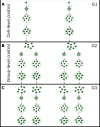Plasticity and the evolution of group-level regulation of cellular differentiation in the volvocine algae
- PMID: 40103550
- PMCID: PMC11920831
- DOI: 10.1098/rspb.2024.2477
Plasticity and the evolution of group-level regulation of cellular differentiation in the volvocine algae
Abstract
During the evolution of multicellularity, the unit of selection transitions from single cells to integrated multicellular cell groups, necessitating the evolution of group-level traits such as somatic differentiation. However, the processes involved in this change in units of selection are poorly understood. We propose that the evolution of soma in the volvocine algae included an intermediate step involving the plastic development of somatic-like cells. We show that Eudorina elegans, a multicellular volvocine algae species previously thought to be undifferentiated, can develop somatic-like cells following environmental stress (i.e. cold shock). These cells resemble obligate soma in closely related species. We find that somatic-like cells can differentiate directly from cold-shocked cells. This differentiation is a cell-level trait, and the differentiated colony phenotype is a cross-level by-product of cell-level processes. The offspring of cold-shocked colonies also develop somatic-like cells. Since these cells were not directly exposed to the stressor, their differentiation was regulated during group development. Consequently, they are a true group-level trait and not a by-product of cell-level traits. We argue that group-level traits, such as obligate somatic differentiation, can originate through plasticity and that cross-level by-products may be an intermediate step in the evolution of group-level traits.
Keywords: cellular differentiation; evolution of multicellularity; individuality; multilevel selection; plasticity; volvocine algae.
Conflict of interest statement
We declare we have no competing interests.
Figures





Similar articles
-
Genetic basis for soma is present in undifferentiated volvocine green algae.J Evol Biol. 2017 Jun;30(6):1205-1218. doi: 10.1111/jeb.13100. Epub 2017 May 13. J Evol Biol. 2017. PMID: 28425150 Free PMC article.
-
Fossil-calibrated molecular clock data enable reconstruction of steps leading to differentiated multicellularity and anisogamy in the Volvocine algae.BMC Biol. 2024 Apr 10;22(1):79. doi: 10.1186/s12915-024-01878-1. BMC Biol. 2024. PMID: 38600528 Free PMC article.
-
Many from one: Lessons from the volvocine algae on the evolution of multicellularity.Commun Integr Biol. 2009 Jul;2(4):368-70. doi: 10.4161/cib.2.4.8611. Commun Integr Biol. 2009. PMID: 19721894 Free PMC article.
-
Evolution of reproductive development in the volvocine algae.Sex Plant Reprod. 2011 Jun;24(2):97-112. doi: 10.1007/s00497-010-0158-4. Epub 2010 Dec 21. Sex Plant Reprod. 2011. PMID: 21174128 Free PMC article. Review.
-
The Genetics of Fitness Reorganization during the Transition to Multicellularity: The Volvocine regA-like Family as a Model.Genes (Basel). 2023 Apr 19;14(4):941. doi: 10.3390/genes14040941. Genes (Basel). 2023. PMID: 37107699 Free PMC article. Review.
Cited by
-
The evolutionary foundations of transcriptional regulation in animals.Nat Rev Genet. 2025 Jul 9. doi: 10.1038/s41576-025-00864-9. Online ahead of print. Nat Rev Genet. 2025. PMID: 40634599 Review.
References
-
- Buss LW. 1987. The evolution of individuality. Princeton, NJ: Princeton University Press. (10.1515/9781400858712) - DOI
-
- Michod R. 1999. Darwinian dynamics: evolutionary transitions in fitness and individuality. Princeton, NJ: Princeton University Press. (10.1515/9780691223865) - DOI
-
- Hanschen ER, Davison DR, Grochau-Wright ZI, Michod RE. 2017. Evolution of individuality: a case study in the volvocine green algae. Philos. Theory Pract. Biol 9, 1-21. (10.3998/ptb.6959004.0009.003) - DOI
-
- Nedelcu AM, Michod RE. 2004. Evolvability, modularity and individuality during the transition to multicellularity in the volvocalean green algae. In Modularity in development and evolution, pp. 466–489. Chicago, IL: University of Chicago Press.
-
- Okasha S. 2006. Evolution and the levels of selection. Oxford, UK: Clarendon Press.
MeSH terms
Grants and funding
LinkOut - more resources
Full Text Sources

